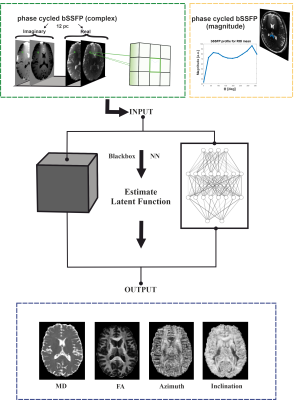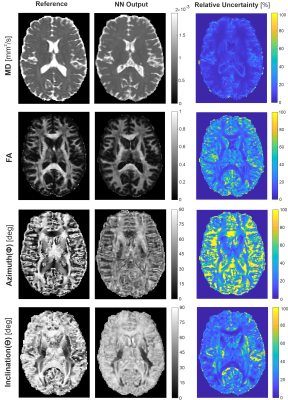Florian Birk1, Felix Glang1, Christoph Birkl2, Klaus Scheffler1,3, and Rahel Heule1,3
1High Field Magnetic Resonance, Max Planck Institute for Biological Cybernetics, Tübingen, Germany, 2Department of Neuroradiology, Medical University of Innsbruck, Innsbruck, Austria, 3Department of Biomedical Magnetic Resonance, University of Tübingen, Tübingen, Germany
1High Field Magnetic Resonance, Max Planck Institute for Biological Cybernetics, Tübingen, Germany, 2Department of Neuroradiology, Medical University of Innsbruck, Innsbruck, Austria, 3Department of Biomedical Magnetic Resonance, University of Tübingen, Tübingen, Germany
Neural
networks proved ability to learn complex dependencies between phase-cycled bSSFP
and DTI data. Direct multi-parametric mapping from bSSFP profiles to diffusion
metrics provided promising results for MD, FA, and the angle ϴ of the principal
diffusion eigenvector relative to B0.

Figure 1. Scheme
of the neural network multi-parametric mapping pipeline. Real and imaginary
parts of the 12-point bSSFP phase-cycling data are fed voxelwise as input into
the NN (green box). For each voxel, a 3x3 window of nearest neighbors in the
axial plane is extracted leading to 216 input features. WM asymmetries in the
magnitude profile are shown for a representative ROI in corpus callosum (orange
box). The trained NNs enable voxelwise predictions of four diffusion metrics:
MD, FA, azimuth (Φ) and inclination (ϴ) (blue box).
